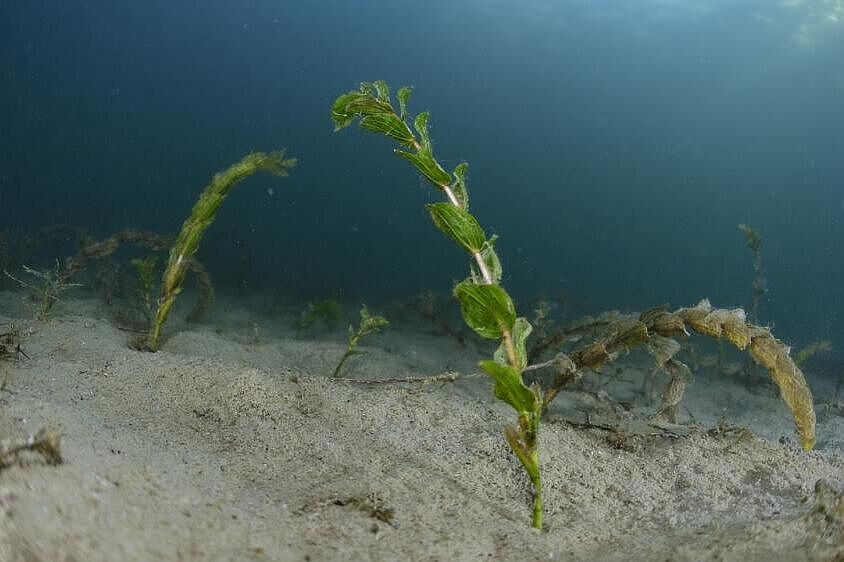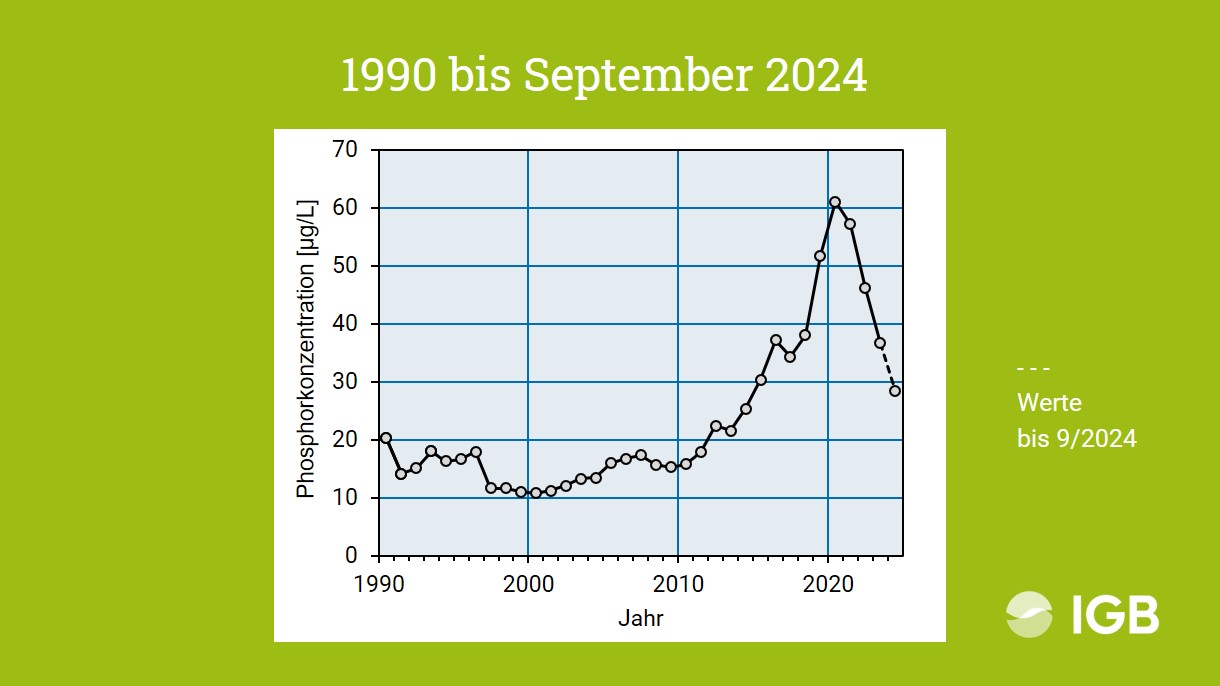New research findings on Lake Stechlin

Shallow water areas are important zones for metabolism, as this study of Lake Stechlin illustrates. | Photo: Solvin Zankl
Even deep clear water lakes, which are considered particularly valuable ecosystems, can show signs of eutrophication and algae growth - often for no apparent reason. A new study by four researchers from the Leibniz Institute of Freshwater Ecology and Inland Fisheries (IGB) now shows that the causes are not always to be found in increasing nutrient inputs from the catchment area or in re-dissolution processes in the deep areas of a lake, but also in the shallower areas up to a water depth of around 20 metres. The team combined long-term data on water chemistry, several years of measurements with sediment traps, sediment analyses and simple mass balance models to decipher the mechanisms behind the sudden eutrophication of Lake Stechlin. The results are not only surprising, they could also apply to similar types of lakes worldwide.
Over-fertilisation, also known as eutrophication, is one of the most pressing environmental problems in lakes worldwide. It is usually caused by man-made nutrient inputs, such as inadequately treated wastewater and fertilisation of agricultural land. The consequences, such as algal blooms, oxygen deficiency and fish mortality, have been known for a long time. However, more and more remote lakes, which are hardly influenced by human activity, are now showing signs of sudden eutrophication. So far, climate change, atmospheric inputs or internal pollution from the depths of the lakes have been discussed as possible causes.
For their study, the IGB team investigated Lake Stechlin, a deep clear-water lake in north-east Germany, which has experienced a dramatic increase in nutrients in recent years. Within just ten years, the phosphorus concentration quadrupled, which was accompanied by algal blooms, oxygen depletion in the deep water and other symptoms of eutrophication.
Shallow water areas: New plant composition and altered sediment properties led to phosphorus increase
The researchers discovered that it is not only processes in the sediments of deeper areas that influence the natural phosphorus retention in the lake, but that the shallow water areas of the lake also play a decisive role. By this, the researchers mean the zones in which light still penetrates to the bottom, which in the Stechlin includes areas up to a water depth of around 20 metres and thus 46 per cent of the lake surface.
In particular, changes in the underwater plants found there and the reduced ability of the sediments to bind phosphorus intensify the internal phosphorus dynamics. So far, so-called regime shifts have mainly been described for shallow lakes, but not for stratified lakes. However, with a maximum depth of almost 70 metres, the Stechlin is one of the deepest lakes in northern Germany.
As the researchers describe, the areas colonised by winter-green stonewort declined sharply, resulting in exposed sediment areas that were gradually colonised by annual, higher aquatic plants. These changes in the vegetation meant that the phosphorus previously bound in plants or sediments was able to enter the water column. The causes of this change in the underwater plant community are still the subject of scientific research and debate.
In addition to the plants, changes in the sediment properties are also an important factor. The scientists found that the uppermost sediment layers contain less iron, which reduces the ability to bind phosphorus. This could have been caused over a period of several decades by the progressive formation of iron sulphide in the shallow and deep sediments of the lake. Iron is increasingly fixed as iron sulphide and is no longer available to bind the phosphorus.
"These complex interactions between plant life and sediment properties could explain why Lake Stechlin has eutrophied so quickly in recent years," explains Dr Thomas Gonsiorczyk, one of the two lead authors of the study. "Even deep lakes can reach a state of severe eutrophication in their shallow water areas as a result of these processes."
Processes in the deep water and external inputs play a subordinate role at Stechlin
The analysis of Lake Stechlin also showed that the increase in phosphorus concentrations cannot be explained by external nutrient inputs. The data analyses even suggest that the phosphorus load from the catchment area has decreased since 1990. Other potential sources such as rewetting measures or the late effects of previous pollution from wastewater from the region, which is heavily frequented by tourists, were also classified as unlikely causes of phosphorus enrichment.
Trend reversal: phosphorus concentrations have been falling since 2020
The phosphorus concentration in the lake has fallen sharply again since 2020. "The phosphorus concentration in the lake in 2024 is only half as high as it was in 2020," says Prof Michael Hupfer, also lead author of the study. However, it remains to be seen whether this development will continue and whether this change will also result in a longer-term trend reversal in the colonisation of underwater plants. The falling phosphorus concentrations have also not yet led to a decisive improvement in oxygen conditions in the deep water.
Relevance for water protection
The results of the current study are of interest for water protection, as many stratified lakes have a high proportion of shallow water in the sense described above despite their depth. Similar processes could therefore take place there. Climate change is exacerbating eutrophication phenomena in lakes through longer summer stratification, heavy rainfall and more frequent storms. "In order to preserve stratified clear water lakes in the long term, protection measures must therefore also include the shallow water areas with more light in the future," emphasises Michael Hupfer. "This could help us to better understand the nutrient dynamics of lakes and develop effective strategies to combat the deterioration of water quality."

Stonewort
Stonewort are not quite algae and not quite plants, but in any case they are a clear indication of low nutrient concentrations and clean waters. And they help to clean the water by binding nutrients, preventing sediment resuspension and favouring particle sedimentation. They are also so low-growing that, compared to other underwater plants, they do not cause any conflicts with recreational use such as swimming or boating, even if they grow vigorously.
Eutrophication
If there are too many nutrients in a water body, this is known as eutrophication. This can lead to (toxic) algal blooms, which can jeopardise drinking water production, for example. In most cases, the causes are man-made: through domestic, industrial and agricultural inputs. To date, Lake Stechlin has been categorised as a nutrient-poor water body.
Stratification
Lakes in temperate zones are subject to strong seasonal cycles that are fundamentally controlled by the physical properties of the water: In summer, surface water heated by the sun stratifies above the permanently cold deep water. This is due to the large temperature-related differences in the density of the water. At 4 °C, it has its greatest density and therefore sinks into the depths. Warmer water remains on the surface. In autumn, when the temperature is equalised by cooling at the surface throughout the lake, the energy carried in by the wind is sufficient to mix the upper and lower water masses completely. Oxygen and nutrients are evenly distributed throughout the entire body of water. This means that they are available again for the production and decomposition of biomass during the stratification phase the following summer.
Thomas Gonsiorczyk; Michael Hupfer; Sabine Hilt; Mark O. Gessner
Global Change Biology. - 30(2024)11, e17575






